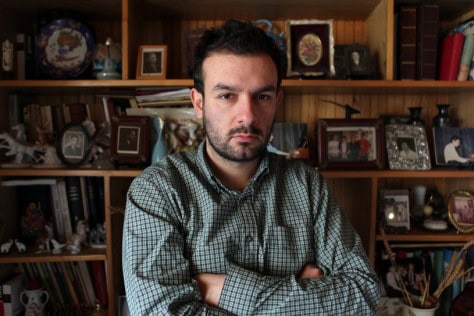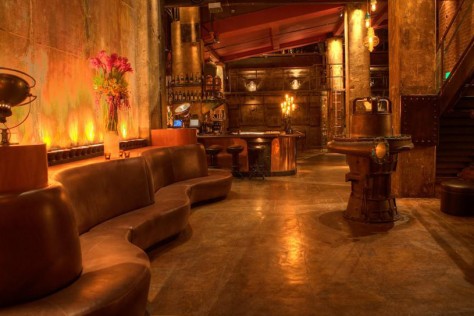Los Angeles-based photographer Augusta Wood has a series of new work currently showing at her brother's (painter Jonas Wood) studio space in Culver City. The show is closing this weekend, and if you live in the Los Angeles area, is well worth a hustle over there to view it before it moves on. Wood's approach to photography is more that of an artist than a documentarian of moments. Her works often contain words or phrases that interact with the imagery and scene. Her latest series of work, “I Have Only What I Remember,” was shot inside her vacant grandparent's home, using layerings of projected slides to approximate her memories of the space from her childhood. We sat down with Wood after the opening to find out more about what drives her work, as well as to bring you her suggestions on an end-of-summer reading list. Enjoy!
When did you first start taking photographs? Was there a pivotal moment when you decided that this was something you wanted to pursue as a career?
My parents remember me saying that I wanted to be an artist when I was 5. When I was younger, I drew a lot and started making photographs when I was 10 or 11, but I don't think I really thought about focusing on photography until I went to art school. I went to Cooper Union [for undergraduate], where you can take any medium you want as long as you fulfill your studio requirements. I took drawing classes, I took photo classes, I took film and video and printmaking. But I ended up gravitating towards photography. It really captivated me. There was something about whole process, the act of looking, thinking about optics, framing, light, working in the darkroom. Then I got my masters in photography and media at CalArts.
Someone once said to me, “If you can't imagine yourself doing anything else, then you're doing what you should be doing.” I could never imagine myself doing anything else, so there wasn't really a question about what path I would take.
Your recent project, “I Have Only What I Remember,” seems filled with a sense of nostalgia. What were your goals with this work?
This series of photographs was made in my grandparents' modernist house. It was a very influential place for me. My grandfather was a doctor and he was also a painter, and my grandmother was a painter; they were both art collectors also. So in a lot of ways, visiting the house [as I was growing up] was my early art education. There was always so much to look at and many spaces to explore.
In this work I'm interested in the relationship between the ways we remember things and the ways photographs depict a place or experience. There's how we remember in our minds, how we remember certain photographs, and then there's negotiating a physical sense of space. To go back and revisit a space that is really familiar to you and how you remember it and how maybe it's different from the way you remembered it.
Since the house was empty, I wanted to remap the way the house used to look when it was lived in back onto the empty architecture, using these slide projections. I specifically chose slides that more closely matched the way I remembered the space. So there's something in there about the subjectivity of memory too―how I remember that space might be different from how my brother might remember that space. The layering of the projections within the house creates spaces within spaces―there's the photographic space that's depicted in the slides and the physical space that they are projected onto, and then I'm making a photograph. So there's a visual exchange within the picture plane where all these layers of space get confusing, which I really like. The seam between what is really in the space and what is in the projected photographs gets a little fuzzy, which I want in the work. The slides are from all different dates, so there is also a collage of various time periods in those layers, pushing the past into the present.
I don't think 'nostalgia' is the right word… I think that's kind of a loaded word. I would distill it down to an exploration of how we relate to memory and photography, time and influence. [This work] is personal, but I'm more interested in addressing these broader questions of space, photography, the psychology of experience and how we remember.
What are your feelings about film versus digital photography?
Well, it's getting harder to do these days, but I've always been committed to shooting film. I just like it better. I like the quality and material nature of it. There are things about shooting digital that have their advantages. It's like digital is the Polaroid of today―the instant gratification. And in some circumstances that's exactly what you need, you need to see it right away. But I like the process of shooting film and working in the darkroom. I like having my hands in it. And there's something really nice about having that anticipation in waiting to get your film back from being processed and being in the darkroom and seeing the image emerge. There's this sense of mystery in that time of waiting. There's something very satisfying about it.
What is your process like?
I'm not a photographer who has her camera on her all the time. I definitely plan out a bigger idea for a project first and then go make photographs. In the process of making the work, of shooting the work, I make discoveries and make decisions.
I tend to work in groupings. It's not often that I make a singular photograph, that stands separately on it's own. I mean, they all function that way―they can each exist as an autonomous image, but there's always a relation to the others in a given project. I think that's just how my brain works. You get to work through lots of permutations and nuances of a larger idea.
What are your interests outside of photography?
Well, I just love art in general. I love reading, I like swimming. I like people watching. People watching's a big one. It's really fascinating to watch how different people carry themselves, how they interact in various situations.
How about a short list of some of your favorite books?
The Miner's Pale Children by W.S. Merwin, The Fortress of Solitude by Jonathan Lethem, Where I'm Calling From by Raymond Carver, The Size of Thoughts by Nicholson Baker
Sept 5–19, 2009
“New Work”
Jonas Wood's Studio
5920 Blackwelder St.
Los Angeles, CA 90232
―
Sept 19–Nov 7, 2009
“Baker's Dozen”
Group Show, Opening Reception Set 19, 6–10 PM
Houston Fotofest Biennial 2010
 Q&A with Larry Gus
Q&A with Larry Gus We Own the Night: The Edison
We Own the Night: The Edison
No Comments